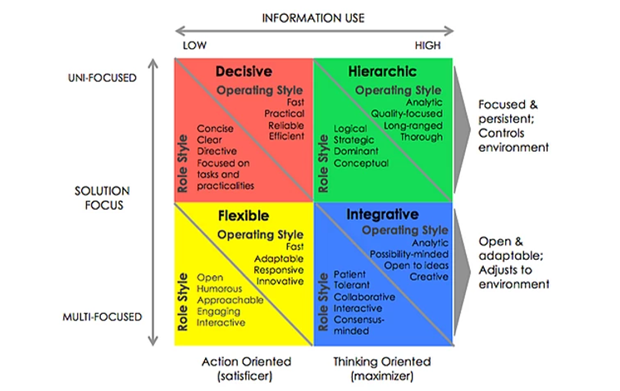Decision-making exists at every level of a corporation. The effects of one decision can cause a chain reaction throughout the organization. This includes, but is not limited to, purchase decisions, strategic planning, talent acquisition or daily activities. According to Dr. Kenneth Brousseau, CEO of Decision Dynamics, there are four common decision styles. Knowing who we are talking to and what their style is can impact how effective we will be at team building, driving change, achieving desired outcomes, increasing engagement and realizing a host of other corporate performance improvement initiatives. As Dr. Brousseau states, “Everything we do stems from a decision we’ve made or a decision we’re making. Different people go about the process of making decisions in often starkly different ways. Awareness of those styles raises our insight to get people on the same page and headed in the right direction.”
4 Common Decision-Making Styles

Dr. Brousseau says the way we make decisions may not always be the same, but we have certain tendencies that can be categorized into four common decision-making styles. They are:
- The Decisive Style: Those with the decisive style tend to stay hyper-focused and use a minimum amount of information to rapidly come to a clear decision. They value action, speed, efficiency and consistency. They prefer to focus on tactics and practical approaches rather than theoretical discourse. When working with a decisive decision-maker, focus on brevity, clarity and planning a course of action.
- The Flexible Style: This style is multi-focused and fluid. Like the decisive style, the flexible style likes to move fast, but for the sake of adaptability rather than rigidity. Individuals with this style quickly will identify potential options and choose one. However, they are prepared to shift to a different course of action if that approach is not working. The flexible style tends to create open-minded environments of mutual support and engagement, with little interest in conflict. Working with decision-makers with the flexible style requires fluidity over commitment and an ability to focus on multiple tasks and associated changes.
- The Hierarchic Style: Individuals with this style tend to operate diametrically opposed to the flexible style. People who make decisions in this way like to analyze all possible routes individually and thoroughly. Then they decide on the best possible course of action. Decisions are based on logic, rationale and detailed specifications that can withstand the test of time and do not require constant adaptation. This style takes decision-making seriously and will expect mutual thoughtfulness with thorough research and preparedness. When working with a person who has this style, allow time for discussion and debate. Be ready to invest the time and focus necessary in the decision-making and planning process.
- The Integrative Style: A person with this style never does the same thing the same way twice. The integrative style looks at every situation as distinct and therefore requires a unique solution. These types of individuals favor innovative and creative solutions, enjoy having their ideas challenged and conduct a thorough analysis of all possible decisions— especially ones that haven’t been made before. The integrative style is highly collaborative, values diverse points of view and thinks of decision-making as an act of exploration. When working with the integrative decision-maker, prepare to discuss the issue at length and the people involved with the challenge before any discussion of solutions.
3 Reasons Why Decision-Making Styles Matter
In a 2019 survey conducted by McKinsey, just over half of respondents reported spending more than 30 percent of their working time on decision-making, and more than one-quarter spend a majority of their time making decisions. That share of time increases with seniority. However, on average, 61 percent say most of their decision-making time is used ineffectively. This is a huge discrepancy. To spend decision-making time more effectively, consider how knowledge of decision-making styles gives decision-makers at all levels a leg up. Here are some tips for effective decision-making:
- Know your own style. If you understand the fundamentals behind how you process and make decisions, you start with an advantage. This awareness allows you to understand what your natural inclination is and how to shift when needed based on the styles of others with whom you are interacting. Brousseau has conducted thorough research on this topic. He states, “Studies show that managers, for example, need to shift their styles as they move up the ladder. Most successful people do adapt different styles at different rungs on the ladder. As you go up you need to make bigger, broader, more strategic decisions, less of the day-to-day tactical stuff and that requires a different way of thinking. You need to be able to see that, sense it and adapt.”
- Know your colleagues’ style. Once you start with the knowledge of your own decision-making style, you can begin to understand the ways your peers work, either similarly or differently from you. Arriving at a consensus and making decisions can be an arduous, taxing and complex process when a team is involved—especially when members don’t see eye to eye. If you know the styles of your peers, your coworkers and your associates, you have a much better chance of adjusting and coordinating your decision-making so you’re on the same page at the same time.
- Know your clients’ style. Understanding decision-making styles helps you communicate effectively and adapt to or anticipate the needs of customers, prospects and other stakeholders. Since understanding the needs, expectations and goals of your clients and prospects is essential, it follows that understanding their decision-making style is equally important.
Growth From Knowledge
Decisions are at the heart of everything we do from daily tasks to large-scale projects. Our budgets, relationships and revenue are all impacted by the decisions made at all levels of the organization. Leaders who understand not only that their peers think differently, but how their peers think differently are in a better position to achieve growth and get employees, executives and stakeholders on the same page and pointed in the right direction.



